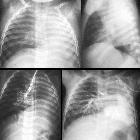Unilateral pulmonary artery atresia













Unilateral pulmonary artery atresia (UPAA), also known as unilateral absence of the pulmonary artery (UAPA) or proximal interruption of the pulmonary artery, is a variant of pulmonary artery atresia.
Terminology
The term interruption is preferred by some to absence or atresia because the anomaly pertains only to the proximal pulmonary artery while the distal pulmonary arterial tree is maintained .
Epidemiology
The estimated prevalence is around 1 in 200,000 young adults. The reported frequency on the right side is slightly greater for some reason .
Clinical presentation
Can be variable and include:
- asymptomatic: adult patients with UPAA are often asymptomatic
- chest pain
- pleural effusion
- recurrent chest infections: lack of arterial blood flow to the affected lung may result in poor delivery of inflammatory cells to sites of inflammation and impaired ciliary function
- dyspnea
- reduced exercise tolerance
- pulmonary hypertension
- hemoptysis
- high-altitude pulmonary edema
Pathology
It commonly occurs on the side opposite to that of the aortic arch.
The distal branches of the affected artery usually remain intact and can be supplied by collateral vessels from other arteries such as bronchial, intercostal, internal thoracic, subdiaphragmatic, subclavian, or even coronary arteries.
Associations
It occurs in association with other cardiac anomalies in ~60% of cases:
In around 40% of cases they occur in isolation, where it is then termed as:
Radiographic features
Features can vary depending on which side is affected.
Plain radiograph
May be seen as volume loss to the ipsilateral lung with and overinflation +/- herniation across the midline of the contralateral lung . The affected lung usually appears hyperlucent due to oligemia, whereas the contralateral lung is supplied by a prominent pulmonary artery.
CT
Allows direct visualization of the absence of the affected pulmonary artery. Volume loss to the affected lung is also shown. Extensive collaterals can be visualized. May allow recognition of associated cardiac anomalies.
Complications
Recognized complications include:
- development of pulmonary hypertension
- hemoptysis
- secondary bronchiectasis from chronic infection
Treatment and prognosis
Treatment is often around the management of complications in asymptomatic individuals. There is often no commonly accepted consensus on a particular treatment strategy.
History and etymology
It is thought to have been first described by O Frantzel in 1868 .
Differential diagnosis
Plain film differential for small lung includes:
Siehe auch:

 Assoziationen und Differentialdiagnosen zu isoliert einseitig fehlende Pulmonalarterie:
Assoziationen und Differentialdiagnosen zu isoliert einseitig fehlende Pulmonalarterie:

